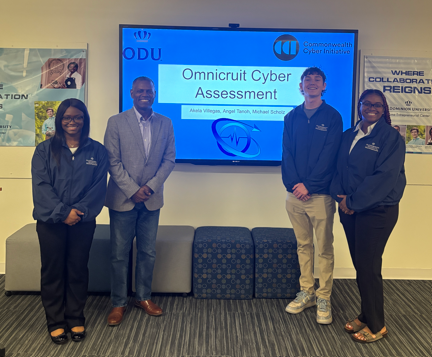01: SolarWinds Supply Chain Attack Paper (2024)
This in-depth research paper examined the SolarWinds supply chain attack, one of the most damaging cyber incidents in recent history. I analyzed how malicious code was inserted into Orion software updates, the ripple effects across government and private networks, and the larger implications for national security. The project demonstrates my ability to research complex threats, break down technical details into accessible explanations, and evaluate long-term cybersecurity risks. It also highlights my understanding of how vulnerabilities in trusted supply chains can be exploited to undermine critical infrastructure.
02: Legal Analysis Memorandum (WA2, 2024)
In this assignment, I wrote a structured memorandum analyzing Fourth Amendment implications in a DEA case involving digital surveillance. The project required me to interpret legal precedents, apply constitutional reasoning to a modern cyber context, and clearly present findings in a professional memo format. This artifact illustrates my ability to bridge technical cybersecurity issues with legal frameworks, an increasingly valuable skill in fields such as digital forensics, law enforcement, and compliance.
03. Cybersecurity Clinic Reflection 2 (2025)
This reflection draws on my experiences working with community organizations through ODU’s Cybersecurity Clinic. I participated in outreach and initial risk assessment activities, including guiding small businesses through cybersecurity awareness and preparedness. This artifact demonstrates not only technical growth, but also soft skills such as professional communication, collaboration, and adapting cybersecurity concepts for non-technical clients. It shows my ability to translate classroom learning into practical consulting experience.
04. Cybersecurity Clinic Reflection 3 (2025)
In my third clinic reflection, I documented the completion of over 50 internship hours where I contributed directly to client projects. I worked on risk assessments, created reports, and drafted executive summaries to communicate findings effectively to business leaders. This artifact highlights growth in project management, applied risk frameworks (such as NIST standards), and real-world problem solving. It also demonstrates my adaptability in professional settings and ability to balance technical details with business needs.

05. Research Paper: Cyber Threats to the U.S. from China (2025)
This scholarly essay explored China’s offensive and defensive cyber capabilities, focusing on military, espionage, and economic impacts. I used peer-reviewed sources and government reports to analyze threat vectors and long-term implications for U.S. national security. The artifact demonstrates advanced research and writing skills, mastery of APA citation, and the ability to synthesize large volumes of information into a cohesive and persuasive argument. It also shows my readiness to contribute to policy and strategy discussions around global cybersecurity.
06. How Awareness Shapes Online Risk – Insights from Nigerian Internet Users (2025)
This artifact is a detailed article review of Emerging Trends in Cybercrime Awareness in Nigeria by Nzeakor et al. (2022). The study surveyed over 1,100 internet users in Umuahia, Nigeria to explore how awareness of different cybercrimes—such as fraud, identity theft, hacking, and cyberterrorism—relates to victimization. My review highlighted surprising findings, including that higher awareness sometimes correlated with increased risk of being a victim.
07. Interdisciplinary Paper on Social Media & Mental Health (2025)
This interdisciplinary essay examined the relationship between adolescent mental health and social media use through the lenses of psychology, education, neuroscience, and ethics. By proposing digital literacy programs as a solution, I demonstrated the ability to integrate research across multiple fields and propose practical interventions. While not strictly a cybersecurity project, this paper illustrates my versatility as a researcher and my ability to connect cybersecurity themes (such as online safety and digital responsibility) with broader social challenges.
8. National Cybersecurity Strategy Review: Focusing on Defending Critical Infrastructure (2025)
This research paper provides an analytical review of the 2023 National Cybersecurity Strategy issued by the Biden Administration, with a particular focus on the first strategic pillar—defending critical infrastructure. I examined how the strategy shifts responsibility for cybersecurity from individuals to organizations with greater resources and technical capacity, emphasizing shared responsibility, accountability for software producers, and stronger federal-private collaboration. The paper evaluates how this approach supports national security by safeguarding sectors like energy, transportation, and healthcare. Through the discussion of real-world examples such as the Colonial Pipeline ransomware attack, the project demonstrates my ability to link policy with practice and to analyze cybersecurity through legal, strategic, and technical lenses. This artifact highlights my skills in critical analysis, policy interpretation, and written communication—key components of cyber policy and governance.
9. Safeguarding the Future (2025)
Safeguarding the Future
This essay integrates key cybersecurity principles and frameworks, such as the CIA Triad, SCADA systems, and the NIST Cybersecurity Framework (CSF), to propose strategies for protecting future digital infrastructures. It begins with a discussion on evolving technologies like artificial intelligence and quantum computing and their potential to outpace traditional security methods. The essay stresses the importance of proactive measures including incident response planning, employee training, and government regulation. I analyzed how concepts like confidentiality, integrity, and availability guide data protection, how SCADA systems can both strengthen and endanger critical infrastructure, and how the NIST framework provides a practical roadmap for risk management and recovery. This artifact showcases my ability to synthesize technical and ethical concepts, apply theoretical frameworks to real-world systems, and communicate complex ideas clearly to diverse audiences.
10. Digital Forensics Case Report: DF-2025-0417 (2025)
This professional forensic report documents my investigation into a suspected data exfiltration case involving a high-ranking U.S. official. As the assigned Certified Digital Forensic Examiner, I conducted physical and logical acquisition of both an Apple iPhone 13 Pro and a Dell Latitude 7430 laptop using industry-standard tools such as FTK Imager, Autopsy, and EnCase.
My work included data hashing for integrity verification, recovery of deleted files, keyword analysis, timeline reconstruction, and cross-device log correlation. Findings revealed encrypted file transfers, deleted browser history, and suspicious correspondence with a foreign contact. The report concludes with documented evidence of intentional obfuscation and potential unauthorized disclosure of classified material. This artifact demonstrates advanced technical competencies in digital forensics, evidence handling, data integrity validation, and analytical reporting—skills essential for investigative cybersecurity roles in law enforcement and national security contexts.